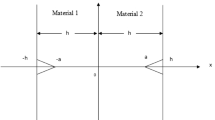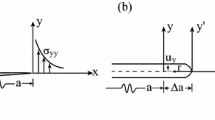Abstract
The boundary element method (BEM) is presented for elastoplastic analysis of cracks between two dissimilar materials. The boundary integral equations and integral representation of stress rates are written in such a form that all integrals can be evaluated by the regular Gaussian quadrature rule. An advanced multidomain BEM formulation is suggested for the solution of analysed problems where the substantial reduction of stiffness matrix is observed. The elastoplastic behaviour is modelled through the use of an approximation for the plastic component of the stresses. The boundary and the yielding zone are discretized by elements with quadratic approximations. In numerical examples the path independence of the J- and L-integrals for a straight interface crack and a circular arc-shaped interface crack are investigated, respectively. The influence of the different values of Young's modulus on the J-integral, shape and size of plastic zones is treated too.
Similar content being viewed by others
References
Aliabadi, M. H.; Rooke, D. P. 1991: Numerical fracture mechanics. Kluwer Academic Publ. Dordrecht
Amestoy, M.; Bui H. D.; Labbens, R. 1981: On the definition of local path independent integrals in three-dimensional crack problems. Mechanics Res. Comm. 8: 231–236
Atluri, S. N. 1982: Path-independent integrals in finite elasticity and inelasticity, with body forces, inertia, and arbitrary crack-face conditions. Engn. Fracture Mech. 16: 341–364
Atluri, S. N. 1986: Energetic approaches and path independent integrals in fracture mechanics. In: Atluri, S. N. (ed.); Computational Methods in the Mechanics of Fracture, 121–127, Elsevier Sci. Publ.
Atluri, S. N.; Nishioka, T.; Nakagaki, M. 1984: Incremental path independent integrals in inelastic and dynamic fracture mechanics. Engn. Fracture Mech. 20: 209–244
Balas, J.; Sladek, J.; Sladek, V. 1989: Stress analysis by boundary element method. Elsevier, Amsterdam
Banerjee, P. K.; Henry, D. P.; Raveendra, S. T. 1989: Advanced inelastic analysis of solids by BEM. Int. J. Mech. Sci. 31: 309–322
Blackburn, W. S.; Jackson, A. D.; Hellen, T. K. 1977: An integral associated with the state of a crack tip in non elastic material. Int. J. Fracture 13: 183–200
Brebbia, C. A.; Telles, J. C. F.; Wrobel, L. C. 1984: Boundary element techniques: theory and applications in engineering Springer-Verlag, Berlin
Chen, F. H. K.; Shield, R. T. 1977: Conservation laws in elasticity of the J-integral type. J. Appl. Math. Phys. (ZAMP) 28: 1–22
Comninou, M. 1977: The interface crack. J. Appl. Mech. 44: 631–636
Cruse, T. A., 1988: Boundary element analysis in computational fracture mechanics. Kluwer Academic Publ., Dordrecht
Dallner, R.; Kuhn, G. 1993: Efficient evaluation of volume integrals in the boundary element method. Computer Meth. Appl. Mech. 109: 95–109
England, A. H. 1965: A crack between dissimilar media. J. Appl. Mech. 32: 400–402
Erdogan, F. 1965: Stress distribution in bonded dissimilar materials with cracks. J. Appl. Mech. 32: 403–410
Eshelby, J. D. 1956: The continuum theory of lattice defects. In: Seitz, F.; Turnbull, D. (eds.) Solid state physics vol. 3, 79–144, Academic Press, New York
Guiggiani, M.; Gigante, A. 1990: A general algorithm for multidimensional Cauchy principal value integrals in the boundary element method. J. Appl. Mech. 57: 906–915
Kita, E.; Kamiya, N. 1994: Subregion boundary element method. JSME Int. Jour. ser. A 37: 366–372
Kishimoto, S.; Aoki, S.; Sakata, M. 1980: On the path independent integral-J. Engn. Fracture Mech. 13: 841–850
Knowles, J. K.; Sternberg, E. 1972: On a class of conservation laws in linearized and finite elastostatics. Arch. Rat. Mech. Anal. 44: 187–211
Leitao, V.; Aliabadi, M. H.; Rooke, D. P. 1993: Contour integrals for elastoplastic boundary element method formulation. Int. J. Fracture 64: R97-R103
Leitao, V.; Aliabadi, M. H.; Rooke, D. P. 1995: The dual boundary element formulation for elastoplastic fracture mechanics. Int. J. Num. Meth. Engn. 38: 315–333
Miyazaki, N.; Ikeda, T.; Soda, T.; Munakata, T. 1993a: Stress intensity factor analysis of interface crack using boundary element method. JSME Int. Jour. ser. A 36: 36–42
Miyazaki, N.; Ikeda, T.; Soda, T.; Munakata, T. 1993b: Stress intensity factor analysis of interface crack using boundary element method — application of contour integral method. Engn. Fracture Mech. 45: 599–610
Murakami, T. (ed.). 1987: Stress intensity factors handbook Pergamon Press, Tokyo
Park, J. H.; Earmme, Y. Y. 1986: Application of conservation integrals to interfacial crack problems. Mech. Materials 5: 261–276
Rice, J. 1968: A path-independent integral and approximate analysis of strain concentrations by notches and cracks. J. Appl. Mech. 35: 379–386
Rice, J. 1988: Elastic fracture mechanics concepts for interfacial cracks. J. Appl. Mech. 55: 98–103
Rice, J.; Sih, G. C. 1965: Plane problems of cracks in dissimilar media. J. Appl. Mech. 32: 418–423
Shih, C. F.; Asaro R. J. 1990: Elastic-plastic and asymptotic fields of interface cracks. Int. J. Fracture 42: 101–116
Sladek, V.; Sladek, J.; Tanaka, M. 1993: Regularization of hypersingular and nearly singular integrals in the potential theory and elasticity. Int. J. Num. Meth. Engn. 36: 1609–1628
Tanaka, M.; Sladek, V.; Sladek, J. 1994: Regularization techniques applied to boundary element methods. Appl. Mech. Rev. 47: 457–499
Williams, M. L. 1959: The stress around a fault or crack in dissimilar media. Bull. Seism. Soc. Amer. 49: 199–204
Xiao, F.; Hui, C. Y. 1994: A boundary element method for calculating the K field for cracks along a bimaterial interface. Comput. Mechanics 15: 58–78
Yuuki, R.; Xu, J. Q. 1994: Boundary element method and its applications to the analyses of dissimilar materials and interface cracks. In: Nisitani, H. (ed.) Computational and experimental fracture mechanics, 61–90, CMP, Southampton
Author information
Authors and Affiliations
Additional information
Communicated by S. N. Atluri, 19 June 1995
Rights and permissions
About this article
Cite this article
Sladek, J., Sladek, V. Boundary element analysis for an interface crack between dissimilar elastoplastic materials. Computational Mechanics 16, 396–405 (1995). https://doi.org/10.1007/BF00370561
Issue Date:
DOI: https://doi.org/10.1007/BF00370561




